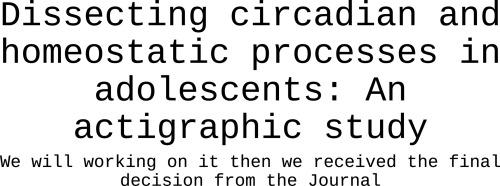Dissecting circadian and homeostatic processes in adolescents: An actigraphic study
IF 3.4
2区 医学
Q1 CLINICAL NEUROLOGY
引用次数: 0
Abstract
The present work used actigraphy to ecologically analyze the roles of circadian and homeostatic processes during the wake-sleep and sleep-wake transitions in adolescents. Four hundred and forty-three adolescents (15.6 ± 1.2 mean age; 45.1 % females) were enrolled in the research and wore an actigraph on the non-dominant wrist for at least three nights. We extracted the minute-by-minute motor activity counts across the wake-sleep transition to depict the motor wake inertia as modulated by the total of the previous wake hour (homeostatic process) or by the time of day of the bedtime (circadian process). The same was done for the sleep-wake transition to analyze whether motor sleep inertia is modulated primarily by the previous total sleep time or by the time of awakening. We performed the Functional Linear Modelling statistical framework in addition to the usual parametric statistics. Overall, results indicate a more substantial role of the homeostatic process in comparison to the circadian process during the wake-sleep transition, while results are less clear for the sleep-wake transition. The findings underscore the importance of ecologically studying the transition phases between wakefulness and sleep, as well as sleep and wakefulness, through actigraphy. To formulate new guidelines aimed at enhancing sleep quality during adolescence, further research is essential. For instance, it would be beneficial to explore how this pattern of outcomes may differ across the lifespan.

剖析青少年的昼夜节律和体内平衡过程:一项活动图研究
本研究利用活动记录仪从生态学角度分析了昼夜节律和体内平衡过程在青少年觉醒-睡眠和睡眠-觉醒转换中的作用。青少年443人(平均年龄15.6±1.2岁);45.1%的女性)参加了这项研究,并在非优势手腕上佩戴了一个活动记录仪至少三晚。我们提取了清醒-睡眠转换过程中每分钟的运动活动计数,以描述由前一个清醒小时的总数(自我平衡过程)或就寝时间(昼夜节律过程)调节的运动觉醒惯性。对睡眠-觉醒转换也做了同样的研究,以分析运动睡眠惯性主要是由之前的总睡眠时间还是觉醒时间调节的。除了通常的参数统计外,我们还执行了功能线性建模统计框架。总的来说,研究结果表明,在清醒-睡眠转换过程中,与昼夜节律过程相比,稳态过程发挥了更重要的作用,而睡眠-觉醒转换的结果则不太清楚。这些发现强调了通过活动记录仪从生态学角度研究清醒和睡眠之间以及睡眠和清醒之间的过渡阶段的重要性。为了制定旨在提高青少年睡眠质量的新指导方针,进一步的研究是必要的。例如,探索这种结果模式在整个生命周期中的差异将是有益的。
本文章由计算机程序翻译,如有差异,请以英文原文为准。
求助全文
约1分钟内获得全文
求助全文
来源期刊

Sleep medicine
医学-临床神经学
CiteScore
8.40
自引率
6.20%
发文量
1060
审稿时长
49 days
期刊介绍:
Sleep Medicine aims to be a journal no one involved in clinical sleep medicine can do without.
A journal primarily focussing on the human aspects of sleep, integrating the various disciplines that are involved in sleep medicine: neurology, clinical neurophysiology, internal medicine (particularly pulmonology and cardiology), psychology, psychiatry, sleep technology, pediatrics, neurosurgery, otorhinolaryngology, and dentistry.
The journal publishes the following types of articles: Reviews (also intended as a way to bridge the gap between basic sleep research and clinical relevance); Original Research Articles; Full-length articles; Brief communications; Controversies; Case reports; Letters to the Editor; Journal search and commentaries; Book reviews; Meeting announcements; Listing of relevant organisations plus web sites.
 求助内容:
求助内容: 应助结果提醒方式:
应助结果提醒方式:


